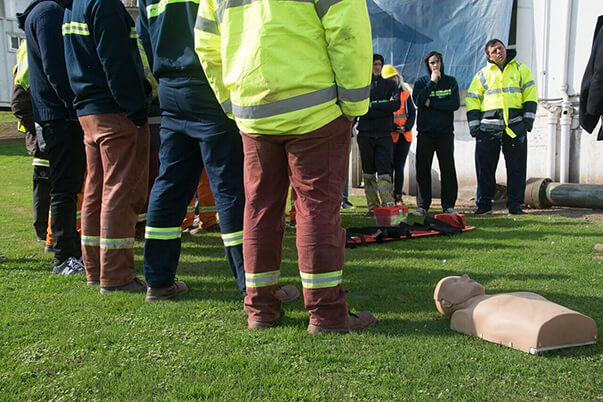You might have seen instances where someone suddenly collapses and becomes unconscious—often due to a sudden lack of blood flow to the heart, commonly known as cardiac arrest. In such critical moments, every second counts. If you find yourself in a situation where someone has collapsed and isn’t breathing, performing CPR (Cardiopulmonary Resuscitation) becomes crucial. CPR can significantly increase the chances of survival until professional help arrives.
In America, approximately 350,000 cases of cardiac arrests outside hospitals are reported each year but only 10% victims survive according to American Heart Association (AHA). Knowing when to do CPR can significantly increase the chances of survival.
CPR is needed in several critical situations, such as cardiac arrest, drowning, choking, drug overdoses, severe allergic reactions, and traumatic injuries. Each of these emergencies presents unique challenges and requires quick action to restore normal breathing and circulation.
By understanding these situations and learning CPR, you can be prepared to act confidently and effectively in life-threatening circumstances.
This write-up highlights the key scenarios where CPR is essential and provides guidance on how to respond, ensuring you’re equipped with the knowledge to potentially save a life.
When Should You Perform CPR?
Cardiopulmonary resuscitation is a life-saving technique used in emergencies when someone’s breathing or heartbeat has stopped. There are a few situations when CPR might be needed.
But, before that you must understand that if you see someone having a cardiac arrest, stay calm and check the situation first. Once you are done with that, you can continue performing CPR. There are numerous situations where you determine when to perform CPR.
Let’s begin discussing those situations:
1. Cardiac Arrest
Cardiac arrest occurs when the heart suddenly stops beating, disrupting blood flow to the brain and other vital organs. The stoppage of heartbeats disrupts blood supply to the brain and other vital organs. It can be caused by different factors such as a heart attack, severe arrhythmia among others. During cardiac arrest, an individual may fall down, lose consciousness or stop breathing entirely apart from occasional gasping for breaths.
Immediate CPR is crucial in this situation as it helps maintain blood flow to the brain and organs until professional medical help arrives, significantly increasing the chances of survival.
2. Unconsciousness
Unconsciousness is said to occur when someone cannot react and breathe normally. Some of the reasons for this state include severe head injuries, strokes, heart attacks or any other medical emergencies.
When people are unconscious and not breathing they suffer from lack of oxygen in their brain among other essential organs which can lead to permanent damage or even death if not treated promptly. According to the American Heart Association (AHA) only an estimated 40% of those who experience cardiac arrest out-of-hospital get immediate care before professional help arrives.
For example, imagine a scenario where a person collapses in a public place due to a heart attack. Bystanders notice that the person is unresponsive and not breathing normally. One of the bystanders, who is trained in CPR, immediately starts chest compressions while another calls emergency services.
This quick response can significantly increase the person’s chances of survival by maintaining blood flow to the brain and other vital organs until professional medical help arrives.
3. Choking
Respiratory arrest occurs when someone stops breathing completely. This can happen suddenly due to choking, drowning, or severe trauma.
A fact is that in some cases, respiratory arrest can be caused by a condition known as “cough syncope,” where a severe cough leads to a temporary loss of consciousness and breathing.
For example, if someone chokes on food and is unable to clear their airway, they may stop breathing. Performing CPR in this situation helps maintain oxygen flow to vital organs until professional help arrives.
4. Severe Trauma
In severe trauma, such as from a major car accident or a fall, CPR becomes crucial if the person’s heart or breathing stops. This is because intense injuries can disrupt normal heart rhythms or damage the lungs, leading to cardiac or respiratory arrest.
In some cases of trauma, especially with severe chest injuries, the heart can temporarily stop beating due to a condition called “cardiac tamponade,” where fluid builds up around the heart, affecting its ability to pump blood.
For example, if someone is in a car crash and their chest is crushed, CPR can help maintain circulation until medical professionals can address the internal injuries and remove any fluid impending heart function.
5. Drug Overdose
A drug overdose occurs when someone takes a substance in quantities that overwhelm the body’s ability to process it, leading to a range of life-threatening effects including slowed or stopped breathing and cardiac arrest. In these cases, CPR is crucial to keep blood flowing and oxygen reaching the brain until professional help arrives.
Here’s an interesting fact: While most experts know that opioids are a common cause of overdose, fewer are aware that substances like over-the-counter cough medicines, which contain dextromethorphan, can also lead to serious respiratory issues if misused.
This highlights the importance of being prepared to perform CPR in a variety of overdose scenarios.
6. Drowning
When someone drowns, their body may stop breathing because water fills the lungs, making it hard for oxygen to enter the bloodstream. Did you know the fact that even if the person is rescued from the water, they might still suffer from “secondary drowning,” where water absorbed into the lungs can cause inflammation and fluid buildup hours later.
For instance, if a child falls into a pool and is quickly pulled out but later shows signs of difficulty breathing, CPR might be needed to help restore normal breathing and circulation until emergency help arrives.
This delayed reaction is why it’s crucial to monitor drowning victims closely, even after they’ve been removed from the water.
7. Electric Shock
Electric shock can cause the heart to stop beating or disrupt its rhythm, leading to a life-threatening situation where CPR becomes essential. When a person is electrocuted, the electric current can interfere with the heart’s electrical signals, causing arrhythmias or cardiac arrest.
Immediate CPR helps maintain blood flow and oxygen to vital organs until emergency help arrives. Interestingly, most experts overlook that even low-voltage shocks can be dangerous if they affect the heart.
A real-life incident highlighting the importance of CPR involved a 48-year-old city electric maintenance worker who was electrocuted while installing lines for police surveillance cameras. Fortunately, basic life support was initiated within 4 minutes by a nearby fire department rescue squad, significantly increasing his chances of survival.
To be prepared for such emergencies, consider opting for Basic Life Support certification, which provides essential skills to handle such critical situations effectively.
How Effective Is CPR?
Medical dramas on TV often make CPR seem more effective than it usually is. For example, some people believe CPR can save up to 75% of those who need it.
However, research shows the survival rates are much lower. A 2010 review of over 150,000 cases found that when bystanders gave CPR, survival rates ranged from 3.9% to 16.1%.
Age also affects survival chances: People in their 70s have about a 6.7% chance of surviving with CPR, while those in their 90s have only a 2.4% chance.
Even if CPR does save a person, they might still face health issues like fatigue, anxiety, or depression, especially if they are older or have pre-existing health conditions.
When Should You Not Do CPR?
If someone is awake and breathing, they don’t need CPR. There are also certain situations where you shouldn’t give CPR. Yes, CPR is a crucial life-saving technique indeed, but there are specific situations where it may not be appropriate or effective:
1. Obvious Signs of Death
Obvious signs of death include clear indicators that the person has passed away and cannot be revived.
For example, if a person has been deceased for a significant time, and their body shows signs of rigor mortis (stiffening) or decomposition (such as a change in skin color or texture), CPR is no longer effective or appropriate.
In another scenario, if someone has sustained a severe injury, such as a decapitation, it is clear that CPR would be futile. Recognizing these signs helps prevent unnecessary efforts and ensures that resources are used appropriately in life-saving situations.
2. Do Not Resuscitate (DNR) Orders
A Do Not Resuscitate (DNR) order is a legal document that specifies a person’s wish to forgo CPR and other life-saving interventions if their heart stops beating or they stop breathing.
This order is often put in place for individuals with terminal illnesses or advanced conditions where resuscitation may not align with their care goals.
For instance, if a patient with advanced cancer has a DNR order, performing CPR against their wishes would not respect their end-of-life preferences. Adhering to a DNR order ensures that medical interventions are in line with the patient’s values and wishes.
3. Unsafe Environment
In a hazardous environment, such as one with fire, toxic fumes, or electrical dangers, attempting CPR can put both the rescuer and the victim at greater risk. Ensuring safety is paramount; rescuers should first address and eliminate immediate threats before performing CPR.
For instance, if there’s an electrical hazard, it’s crucial to turn off the power or move the victim to a safe area before starting CPR.
Prioritizing safety prevents additional injuries or complications and ensures that both the rescuer and the victim are protected during the emergency response.
4. Medical Conditions
In certain situations, performing CPR might not be appropriate if a person has a terminal illness or is receiving palliative care, where the focus is on comfort rather than extending life.
For instance, individuals with advanced-stage cancer or end-stage organ failure may have made the decision with their healthcare provider to forego aggressive life-saving measures like CPR in favor of a more peaceful and dignified end-of-life experience.
In these cases, administering CPR could go against their established care plan and personal wishes, making it important to respect these decisions and focus on providing comfort and quality of life instead.
5. Effective Bystander and Professional Assessment
In some cases, if medical professionals assess the situation and determine that performing CPR would be ineffective or futile due to the patient’s condition or circumstances, CPR should not be administered.
This assessment takes into account various factors, such as the likelihood of survival, the underlying cause of cardiac arrest, and the overall prognosis.
It is essential to respect the medical judgment of professionals who are trained to make these decisions based on their expertise and experience.
Get Trained in CPR and Save Lives
Knowing when to use CPR can be a vital skill in emergencies. Whether it’s cardiac arrest, drowning, choking, drug overdose, severe allergic reactions, or trauma, being prepared to perform CPR can make a significant difference.
Understanding the signs and appropriate actions in these situations ensures that you can respond quickly and effectively.
Learning CPR equips you with the confidence and ability to act during critical moments, potentially saving lives. If you haven’t already, consider taking a CPR course to refresh your skills and stay prepared.
Remember, your readiness can turn a challenging situation into a life-saving opportunity, helping others in their time of need.









